INFINITI Q50 2021 Service Manual
Manufacturer: INFINITI, Model Year: 2021, Model line: Q50, Model: INFINITI Q50 2021Pages: 484, PDF Size: 1.86 MB
Page 41 of 484
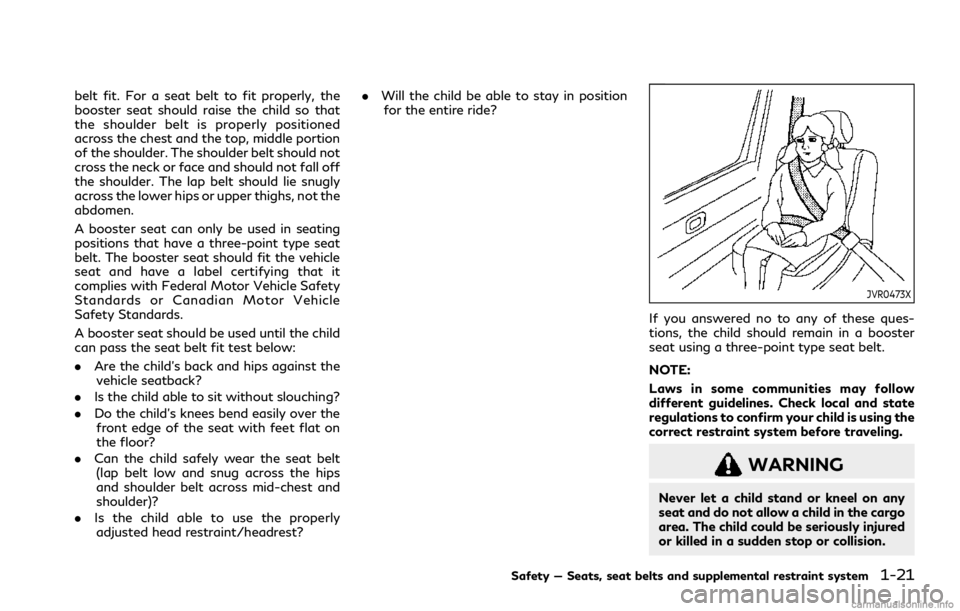
belt fit. For a seat belt to fit properly, the
booster seat should raise the child so that
the shoulder belt is properly positioned
across the chest and the top, middle portion
of the shoulder. The shoulder belt should not
cross the neck or face and should not fall off
the shoulder. The lap belt should lie snugly
across the lower hips or upper thighs, not the
abdomen.
A booster seat can only be used in seating
positions that have a three-point type seat
belt. The booster seat should fit the vehicle
seat and have a label certifying that it
complies with Federal Motor Vehicle Safety
Standards or Canadian Motor Vehicle
Safety Standards.
A booster seat should be used until the child
can pass the seat belt fit test below:
.Are the child’s back and hips against the
vehicle seatback?
. Is the child able to sit without slouching?
. Do the child’s knees bend easily over the
front edge of the seat with feet flat on
the floor?
. Can the child safely wear the seat belt
(lap belt low and snug across the hips
and shoulder belt across mid-chest and
shoulder)?
. Is the child able to use the properly
adjusted head restraint/headrest? .
Will the child be able to stay in position
for the entire ride?
JVR0473X
If you answered no to any of these ques-
tions, the child should remain in a booster
seat using a three-point type seat belt.
NOTE:
Laws in some communities may follow
different guidelines. Check local and state
regulations to confirm your child is using the
correct restraint system before traveling.
WARNING
Never let a child stand or kneel on any
seat and do not allow a child in the cargo
area. The child could be seriously injured
or killed in a sudden stop or collision.
Safety — Seats, seat belts and supplemental restraint system1-21
Page 42 of 484
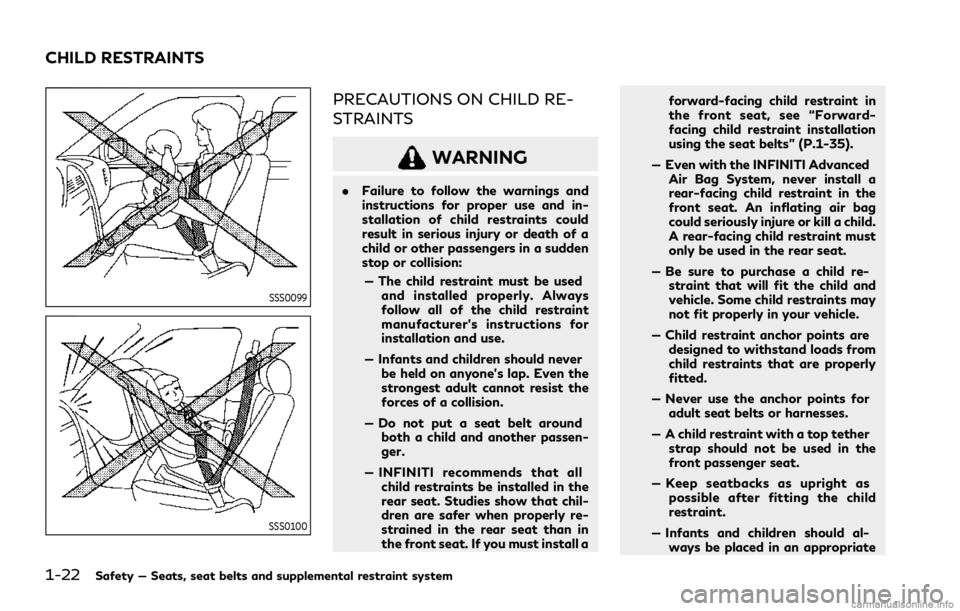
1-22Safety — Seats, seat belts and supplemental restraint system
SSS0099
SSS0100
PRECAUTIONS ON CHILD RE-
STRAINTS
WARNING
.Failure to follow the warnings and
instructions for proper use and in-
stallation of child restraints could
result in serious injury or death of a
child or other passengers in a sudden
stop or collision:
— The child restraint must be used and installed properly. Always
follow all of the child restraint
manufacturer’s instructions for
installation and use.
— Infants and children should never be held on anyone’s lap. Even the
strongest adult cannot resist the
forces of a collision.
— Do not put a seat belt around both a child and another passen-
ger.
— INFINITI recommends that all child restraints be installed in the
rear seat. Studies show that chil-
dren are safer when properly re-
strained in the rear seat than in
the front seat. If you must install a forward-facing child restraint in
the front seat, see “Forward-
facing child restraint installation
using the seat belts” (P.1-35).
— Even with the INFINITI Advanced Air Bag System, never install a
rear-facing child restraint in the
front seat. An inflating air bag
could seriously injure or kill a child.
A rear-facing child restraint must
only be used in the rear seat.
— Be sure to purchase a child re- straint that will fit the child and
vehicle. Some child restraints may
not fit properly in your vehicle.
— Child restraint anchor points are designed to withstand loads from
child restraints that are properly
fitted.
— Never use the anchor points for adult seat belts or harnesses.
— A child restraint with a top tether strap should not be used in the
front passenger seat.
— Keep seatbacks as upright as possible after fitting the child
restraint.
— Infants and children should al- ways be placed in an appropriate
CHILD RESTRAINTS
Page 43 of 484
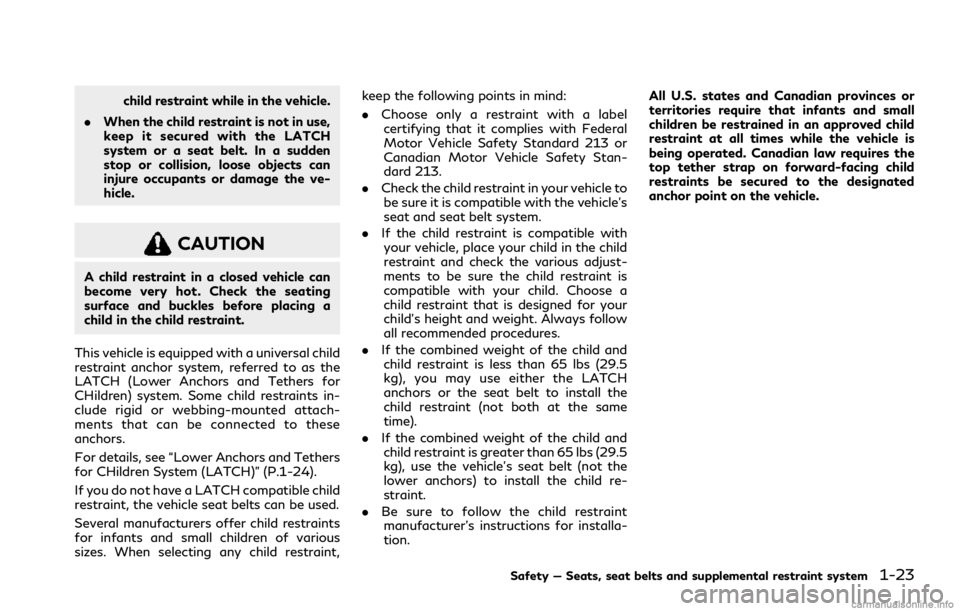
child restraint while in the vehicle.
. When the child restraint is not in use,
keep it secured with the LATCH
system or a seat belt. In a sudden
stop or collision, loose objects can
injure occupants or damage the ve-
hicle.
CAUTION
A child restraint in a closed vehicle can
become very hot. Check the seating
surface and buckles before placing a
child in the child restraint.
This vehicle is equipped with a universal child
restraint anchor system, referred to as the
LATCH (Lower Anchors and Tethers for
CHildren) system. Some child restraints in-
clude rigid or webbing-mounted attach-
ments that can be connected to these
anchors.
For details, see “Lower Anchors and Tethers
for CHildren System (LATCH)” (P.1-24).
If you do not have a LATCH compatible child
restraint, the vehicle seat belts can be used.
Several manufacturers offer child restraints
for infants and small children of various
sizes. When selecting any child restraint, keep the following points in mind:
.
Choose only a restraint with a label
certifying that it complies with Federal
Motor Vehicle Safety Standard 213 or
Canadian Motor Vehicle Safety Stan-
dard 213.
. Check the child restraint in your vehicle to
be sure it is compatible with the vehicle’s
seat and seat belt system.
. If the child restraint is compatible with
your vehicle, place your child in the child
restraint and check the various adjust-
ments to be sure the child restraint is
compatible with your child. Choose a
child restraint that is designed for your
child’s height and weight. Always follow
all recommended procedures.
. If the combined weight of the child and
child restraint is less than 65 lbs (29.5
kg), you may use either the LATCH
anchors or the seat belt to install the
child restraint (not both at the same
time).
. If the combined weight of the child and
child restraint is greater than 65 lbs (29.5
kg), use the vehicle’s seat belt (not the
lower anchors) to install the child re-
straint.
. Be sure to follow the child restraint
manufacturer’s instructions for installa-
tion. All U.S. states and Canadian provinces or
territories require that infants and small
children be restrained in an approved child
restraint at all times while the vehicle is
being operated. Canadian law requires the
top tether strap on forward-facing child
restraints be secured to the designated
anchor point on the vehicle.
Safety — Seats, seat belts and supplemental restraint system1-23
Page 44 of 484
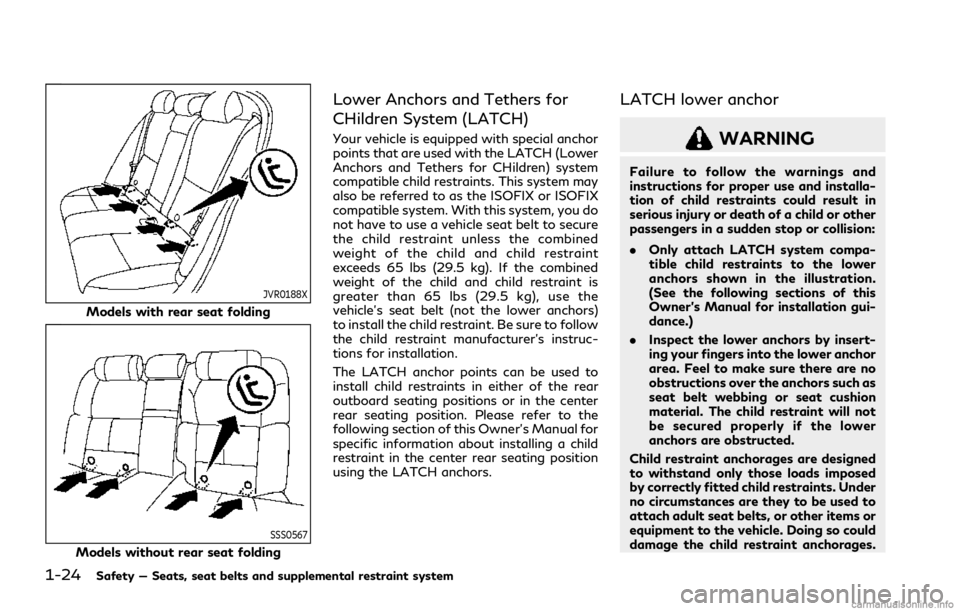
1-24Safety — Seats, seat belts and supplemental restraint system
JVR0188X
Models with rear seat folding
SSS0567
Models without rear seat folding
Lower Anchors and Tethers for
CHildren System (LATCH)
Your vehicle is equipped with special anchor
points that are used with the LATCH (Lower
Anchors and Tethers for CHildren) system
compatible child restraints. This system may
also be referred to as the ISOFIX or ISOFIX
compatible system. With this system, you do
not have to use a vehicle seat belt to secure
the child restraint unless the combined
weight of the child and child restraint
exceeds 65 lbs (29.5 kg). If the combined
weight of the child and child restraint is
greater than 65 lbs (29.5 kg), use the
vehicle’s seat belt (not the lower anchors)
to install the child restraint. Be sure to follow
the child restraint manufacturer’s instruc-
tions for installation.
The LATCH anchor points can be used to
install child restraints in either of the rear
outboard seating positions or in the center
rear seating position. Please refer to the
following section of this Owner’s Manual for
specific information about installing a child
restraint in the center rear seating position
using the LATCH anchors.
LATCH lower anchor
WARNING
Failure to follow the warnings and
instructions for proper use and installa-
tion of child restraints could result in
serious injury or death of a child or other
passengers in a sudden stop or collision:
.Only attach LATCH system compa-
tible child restraints to the lower
anchors shown in the illustration.
(See the following sections of this
Owner’s Manual for installation gui-
dance.)
. Inspect the lower anchors by insert-
ing your fingers into the lower anchor
area. Feel to make sure there are no
obstructions over the anchors such as
seat belt webbing or seat cushion
material. The child restraint will not
be secured properly if the lower
anchors are obstructed.
Child restraint anchorages are designed
to withstand only those loads imposed
by correctly fitted child restraints. Under
no circumstances are they to be used to
attach adult seat belts, or other items or
equipment to the vehicle. Doing so could
damage the child restraint anchorages.
Page 45 of 484
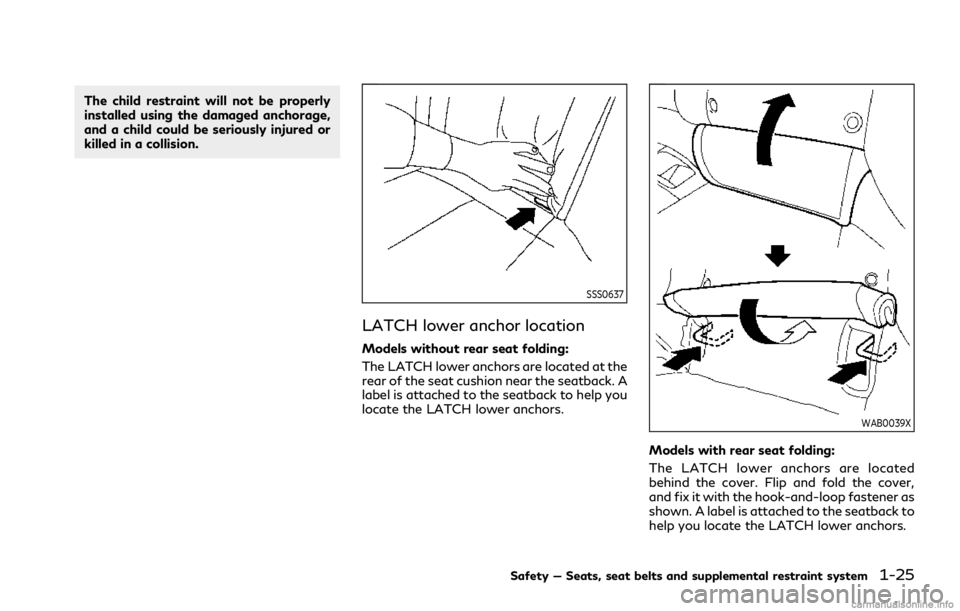
The child restraint will not be properly
installed using the damaged anchorage,
and a child could be seriously injured or
killed in a collision.
SSS0637
LATCH lower anchor location
Models without rear seat folding:
The LATCH lower anchors are located at the
rear of the seat cushion near the seatback. A
label is attached to the seatback to help you
locate the LATCH lower anchors.
WAB0039X
Models with rear seat folding:
The LATCH lower anchors are located
behind the cover. Flip and fold the cover,
and fix it with the hook-and-loop fastener as
shown. A label is attached to the seatback to
help you locate the LATCH lower anchors.
Safety — Seats, seat belts and supplemental restraint system1-25
Page 46 of 484
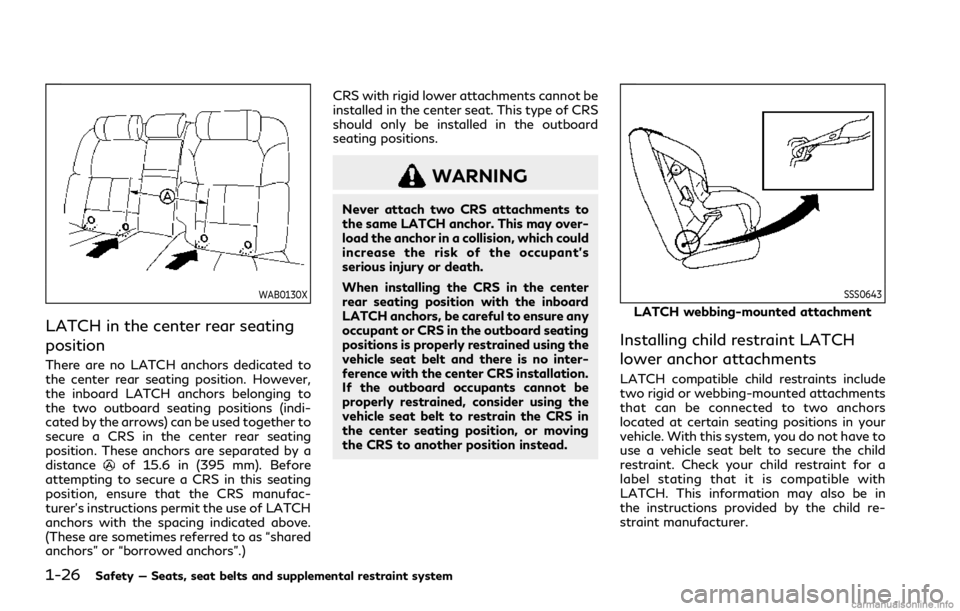
1-26Safety — Seats, seat belts and supplemental restraint system
WAB0130X
LATCH in the center rear seating
position
There are no LATCH anchors dedicated to
the center rear seating position. However,
the inboard LATCH anchors belonging to
the two outboard seating positions (indi-
cated by the arrows) can be used together to
secure a CRS in the center rear seating
position. These anchors are separated by a
distance
of 15.6 in (395 mm). Before
attempting to secure a CRS in this seating
position, ensure that the CRS manufac-
turer’s instructions permit the use of LATCH
anchors with the spacing indicated above.
(These are sometimes referred to as “shared
anchors” or “borrowed anchors”.) CRS with rigid lower attachments cannot be
installed in the center seat. This type of CRS
should only be installed in the outboard
seating positions.
WARNING
Never attach two CRS attachments to
the same LATCH anchor. This may over-
load the anchor in a collision, which could
increase the risk of the occupant’s
serious injury or death.
When installing the CRS in the center
rear seating position with the inboard
LATCH anchors, be careful to ensure any
occupant or CRS in the outboard seating
positions is properly restrained using the
vehicle seat belt and there is no inter-
ference with the center CRS installation.
If the outboard occupants cannot be
properly restrained, consider using the
vehicle seat belt to restrain the CRS in
the center seating position, or moving
the CRS to another position instead.
SSS0643
LATCH webbing-mounted attachment
Installing child restraint LATCH
lower anchor attachments
LATCH compatible child restraints include
two rigid or webbing-mounted attachments
that can be connected to two anchors
located at certain seating positions in your
vehicle. With this system, you do not have to
use a vehicle seat belt to secure the child
restraint. Check your child restraint for a
label stating that it is compatible with
LATCH. This information may also be in
the instructions provided by the child re-
straint manufacturer.
Page 47 of 484
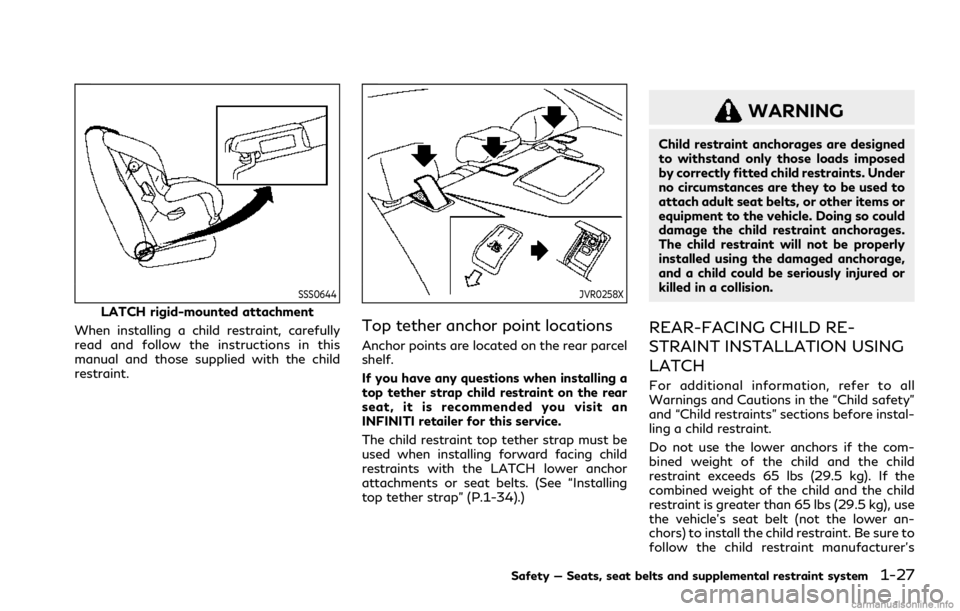
SSS0644
LATCH rigid-mounted attachment
When installing a child restraint, carefully
read and follow the instructions in this
manual and those supplied with the child
restraint.
JVR0258X
Top tether anchor point locations
Anchor points are located on the rear parcel
shelf.
If you have any questions when installing a
top tether strap child restraint on the rear
seat, it is recommended you visit an
INFINITI retailer for this service.
The child restraint top tether strap must be
used when installing forward facing child
restraints with the LATCH lower anchor
attachments or seat belts. (See “Installing
top tether strap” (P.1-34).)
WARNING
Child restraint anchorages are designed
to withstand only those loads imposed
by correctly fitted child restraints. Under
no circumstances are they to be used to
attach adult seat belts, or other items or
equipment to the vehicle. Doing so could
damage the child restraint anchorages.
The child restraint will not be properly
installed using the damaged anchorage,
and a child could be seriously injured or
killed in a collision.
REAR-FACING CHILD RE-
STRAINT INSTALLATION USING
LATCH
For additional information, refer to all
Warnings and Cautions in the “Child safety”
and “Child restraints” sections before instal-
ling a child restraint.
Do not use the lower anchors if the com-
bined weight of the child and the child
restraint exceeds 65 lbs (29.5 kg). If the
combined weight of the child and the child
restraint is greater than 65 lbs (29.5 kg), use
the vehicle’s seat belt (not the lower an-
chors) to install the child restraint. Be sure to
follow the child restraint manufacturer’s
Safety — Seats, seat belts and supplemental restraint system1-27
Page 48 of 484

1-28Safety — Seats, seat belts and supplemental restraint system
instructions for installation.
Follow these steps to install a rear-facing
child restraint using the LATCH system:
1. Position the child restraint on the seat.Always follow the child restraint manu-
facturer’s instructions.
SSS0648
Rear-facing web-mounted — step 2
2. Secure the child restraint anchor attach- ments to the LATCH lower anchors.
Check to make sure the LATCH attach-
ment is properly attached to the lower
anchors.
SSS0649
Rear-facing rigid-mounted — step 2
Page 49 of 484

SSS0639
Rear-facing — step 3
3. For child restraints that are equipped with webbing-mounted attachments, re-
move any additional slack from the
anchor attachments. Press downward
and rearward firmly in the center of the
child restraint with your hand to com-
press the vehicle seat cushion and seat-
back while tightening the webbing of the
anchor attachments.
SSS0650
Rear-facing — step 4
4. After attaching the child restraint, test it before you place the child in it. Push it
from side to side while holding the child
restraint near the LATCH attachment
path. The child restraint should not move
more than 1 inch (25 mm), from side to
side. Try to tug it forward and check to
see if the LATCH attachment holds the
restraint in place. If the restraint is not
secure, tighten the LATCH attachment
as necessary, or put the restraint in
another seat and test it again. You may
need to try a different child restraint or
try installing by using the vehicle seat
belt (if applicable). Not all child restraints
fit in all types of vehicles. 5. Check to make sure the child restraint is
properly secured prior to each use. If the
child restraint is loose, repeat steps 1
through 4.
Safety — Seats, seat belts and supplemental restraint system1-29
Page 50 of 484
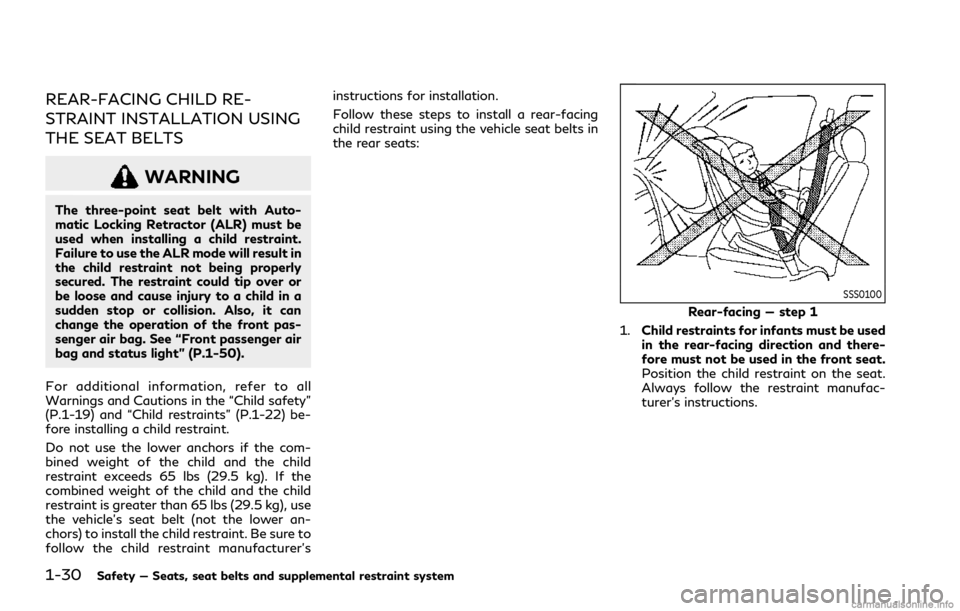
1-30Safety — Seats, seat belts and supplemental restraint system
REAR-FACING CHILD RE-
STRAINT INSTALLATION USING
THE SEAT BELTS
WARNING
The three-point seat belt with Auto-
matic Locking Retractor (ALR) must be
used when installing a child restraint.
Failure to use the ALR mode will result in
the child restraint not being properly
secured. The restraint could tip over or
be loose and cause injury to a child in a
sudden stop or collision. Also, it can
change the operation of the front pas-
senger air bag. See “Front passenger air
bag and status light” (P.1-50).
For additional information, refer to all
Warnings and Cautions in the “Child safety”
(P.1-19) and “Child restraints” (P.1-22) be-
fore installing a child restraint.
Do not use the lower anchors if the com-
bined weight of the child and the child
restraint exceeds 65 lbs (29.5 kg). If the
combined weight of the child and the child
restraint is greater than 65 lbs (29.5 kg), use
the vehicle’s seat belt (not the lower an-
chors) to install the child restraint. Be sure to
follow the child restraint manufacturer’s instructions for installation.
Follow these steps to install a rear-facing
child restraint using the vehicle seat belts in
the rear seats:
SSS0100
Rear-facing — step 1
1. Child restraints for infants must be used
in the rear-facing direction and there-
fore must not be used in the front seat.
Position the child restraint on the seat.
Always follow the restraint manufac-
turer’s instructions.